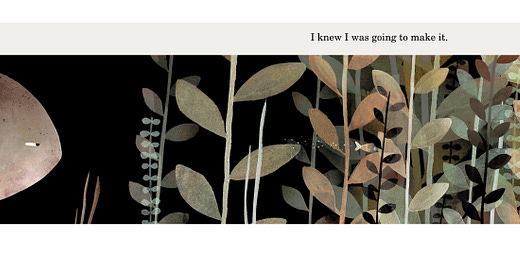There’s a place that dark comedy goes where other children’s tales fear to tread. A modern phenomenon, relatively speaking.
Here’s EB White (of Charlotte’s Web; also, incidentally, of Strunk & White) responding to criticism about the vile nature of his protagonist and all that talk about death:
I am working on a new book about a boa constrictor and a litter of hyenas. The boa constrictor swallows the babies one by one, and the mother hyena dies laughing.
But what happens on the other side of dark comedy?
If you haven’t yet read Jon Klassen’s The Hat Trilogy—I Want My Hat Back; This Is Not My Hat; We Found a Hat—you should stop here and locate and read the three books in order. The order is important. Book trailers below.
Klassen hits upon his beautiful visual language early on, but the words take longer to perfect. There is an endearing awkwardness to the words of the first book, the Theodor Seuss Geisel Honor-ed I Want My Hat Back, but it works in favour of the characters, and is, therefore, in service of the story. Stakes are up a notch in the Caldecott Medal-winning second, This Is Not My Hat, images and words slyly gaining on each other, swimming at top speed from left to right.
The hero or heroine is the one who sees what is appropriate to be done, because he or she sees the whole, which is greater than either evil or good. Their heroism is, in fact, their certainty. They do not act by rules; they simply know the way to go.
– Ursula K Le Guin, The Child and the Shadow, The Language of the Night
It is in the third, We Found a Hat, that we see the other side. Not a single stroke or eye position is out of place, not one word wrong. The story breaks free of everything, even its own author, and emerges like a star. It’s perfect.
It is the animal who knows the way, the way home. It is the animal within us, the primitive, the dark brother, the shadow soul, who is the guide.
There is often a queer twist to this in folktales, a kind of final secret. The helpful animal, often a horse or a wolf, says to the hero, “When you have done such-and-so with my help, then you must kill me, cut off my head.” And the hero must trust his animal guide so wholly that he is willing to do so. Apparently the meaning of this is that when you have followed the animal instincts far enough, then they must be sacrificed, so that the true self, the whole person, may step forth from the body of the animal, reborn.
– Ursula K Le Guin, The Child and the Shadow, The Language of the Night
The doubling of the double finds resolution.
The whole comes to be.
The way to go is seen.
Image: A screenshot from my library copy of This Is Not My Hat. © Jon Klassen
#image #word #life #death #darkcomedy
Yes, the trailers are hard to resist.




